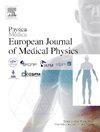数字变异和减影血管造影术在下肢血管造影中的效果比较:蒙特卡罗建模方法
IF 3.3
3区 医学
Q1 RADIOLOGY, NUCLEAR MEDICINE & MEDICAL IMAGING
Physica Medica-European Journal of Medical Physics
Pub Date : 2024-11-25
DOI:10.1016/j.ejmp.2024.104859
引用次数: 0
摘要
本研究通过对介入手术的患者暴露进行建模,比较了数字变异血管造影术(DVA)和数字减影血管造影术(DSA)之间辐射危害的减少情况。本文介绍了使用内部开发的工具对用于诊断外周动脉疾病(PAD)的 DVA 临床试验中 107 例患者暴露进行的回顾性风险评估。DICOM 暴露参数用于启动 PENELOPE(正电子和电子的穿透和能量分布)蒙特卡罗模拟、辐射质量和数量以及照射几何形状。癌症发病率和死亡率的有效剂量和终生可归因风险(LAR)分别根据国际辐射防护委员会(ICRP)第 103 号建议和电离辐射生物效应委员会(BEIR VII)的最新报告计算得出。DVA 组的集体有效剂量比 DSA 组低 58%。相应地,不同器官的 LAR 癌症发病率(25%-75%)和死亡率(51%-84%)也大幅降低。DVA 的使用有助于优化对患者的辐射防护,并符合 ALARA(尽可能低)原则。本文章由计算机程序翻译,如有差异,请以英文原文为准。
Comparative effectiveness of digital variance and subtraction angiography in lower limb angiography: A Monte Carlo modelling approach
Objective
By modelling patient exposures of interventional procedures, this study compares the reduction of radiation detriment between Digital Variance Angiography (DVA) and Digital Subtraction Angiography (DSA).
Methods
The paper presents a retrospective risk assessment using an in-house developed tool on 107 patient exposures from a clinical trial of DVA used to diagnose peripheral arterial disease (PAD). DICOM exposure parameters were used to initiate the PENELOPE (PENetration and Energy LOss of Positrons and Electrons) Monte Carlo simulation, radiation quality and quantity, and irradiation geometry. The effective dose and the lifetime attributable risk (LAR) for cancer incidence and mortality are calculated based on the International Commission on Radiation Protection’s (ICRP) 103 recommendations and the Committee on the Biological Effects of Ionising Radiations’ latest (BEIR VII) report, respectively.
Results
The study found that procedures conducted using DVA significantly reduce the radiation exposure of patients, compared to DSA. The collective effective dose for the DVA group was 58% lower than that for the DSA group. Correspondingly, the LAR of different organs showed a substantial decrease for cancer incidence (25–75%) and mortality (51–84%).
Conclusion
DVA demonstrates a considerable reduction in physical dosimetric quantities and consequently effective dose and cancer risk, suggesting its potential as a safer alternative to DSA in interventional radiology. The use of DVA supports the optimisation of patient radiation protection and aligns with the principles of ALARA (as low as reasonably achievable).
求助全文
通过发布文献求助,成功后即可免费获取论文全文。
去求助
来源期刊
CiteScore
6.80
自引率
14.70%
发文量
493
审稿时长
78 days
期刊介绍:
Physica Medica, European Journal of Medical Physics, publishing with Elsevier from 2007, provides an international forum for research and reviews on the following main topics:
Medical Imaging
Radiation Therapy
Radiation Protection
Measuring Systems and Signal Processing
Education and training in Medical Physics
Professional issues in Medical Physics.

 求助内容:
求助内容: 应助结果提醒方式:
应助结果提醒方式:


